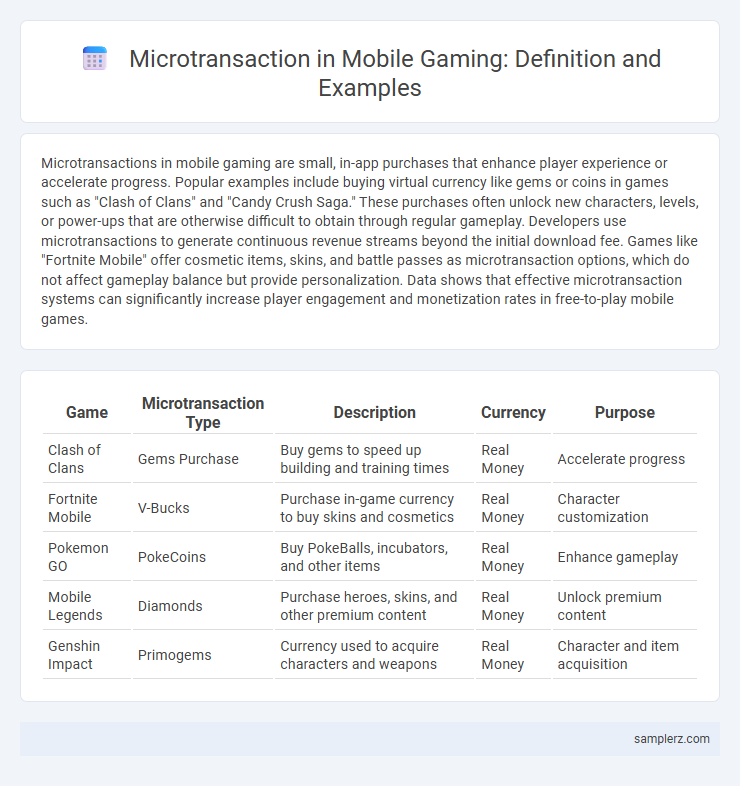Microtransactions in mobile gaming are small, in-app purchases that enhance player experience or accelerate progress. Popular examples include buying virtual currency like gems or coins in games such as "Clash of Clans" and "Candy Crush Saga." These purchases often unlock new characters, levels, or power-ups that are otherwise difficult to obtain through regular gameplay. Developers use microtransactions to generate continuous revenue streams beyond the initial download fee. Games like "Fortnite Mobile" offer cosmetic items, skins, and battle passes as microtransaction options, which do not affect gameplay balance but provide personalization. Data shows that effective microtransaction systems can significantly increase player engagement and monetization rates in free-to-play mobile games.
Table of Comparison
| Game | Microtransaction Type | Description | Currency | Purpose |
|---|---|---|---|---|
| Clash of Clans | Gems Purchase | Buy gems to speed up building and training times | Real Money | Accelerate progress |
| Fortnite Mobile | V-Bucks | Purchase in-game currency to buy skins and cosmetics | Real Money | Character customization |
| Pokemon GO | PokeCoins | Buy PokeBalls, incubators, and other items | Real Money | Enhance gameplay |
| Mobile Legends | Diamonds | Purchase heroes, skins, and other premium content | Real Money | Unlock premium content |
| Genshin Impact | Primogems | Currency used to acquire characters and weapons | Real Money | Character and item acquisition |
Introduction to Microtransactions in Mobile Gaming
Microtransactions in mobile gaming allow players to purchase in-game items such as character skins, power-ups, or virtual currency using real money. Popular titles like "Clash of Clans" and "Candy Crush Saga" generate significant revenue through microtransactions by offering convenience and customization options. These small, often inexpensive purchases enhance gameplay experience and drive mobile game monetization strategies.
Common Types of Microtransactions in Mobile Games
Common types of microtransactions in mobile games include in-app purchases for virtual currency, cosmetic items such as skins and character outfits, and energy or resource packs that accelerate gameplay progression. Players often buy loot boxes containing randomized rewards, and subscription services offering exclusive content or bonuses. These microtransactions drive revenue by enhancing user engagement and personalization within free-to-play mobile games.
In-App Purchases: Unlocking Levels and Features
In mobile gaming, microtransactions often involve in-app purchases that unlock additional levels and exclusive features, enhancing gameplay experience. Players can buy new characters, power-ups, or premium content that provide strategic advantages or aesthetic customization. This monetization model drives revenue by offering optional content that increases engagement and player retention.
Cosmetic Upgrades: Skins, Avatars, and Customization
Microtransactions in mobile gaming often include cosmetic upgrades such as skins, avatars, and customization options that allow players to personalize their characters or in-game items without affecting gameplay. Popular titles like Fortnite Mobile and PUBG Mobile generate significant revenue by offering exclusive cosmetic skins and avatar accessories available for purchase through in-game stores. These microtransactions enhance user engagement by providing visual differentiation and a sense of uniqueness, driving consistent monetization through non-essential aesthetic content.
Gacha Systems and Loot Boxes Explained
Gacha systems in mobile gaming function by allowing players to spend in-game currency or real money to receive randomized virtual items, characters, or enhancements, mimicking a lottery or slot machine mechanism. Loot boxes operate similarly by offering players a chance-based reward system where purchased boxes contain varied in-game content, ranging from cosmetic items to gameplay advantages. Both microtransaction models drive significant revenue for developers while often sparking debate over fairness and the potential for encouraging gambling-like behaviors.
Energy Refills and Gameplay Accelerators
Energy refills allow players to instantly restore stamina or action points, enabling extended play sessions without waiting for natural regeneration. Gameplay accelerators, such as speed boosts or instant construction timers, help users progress faster in mobile games by reducing downtime and unlocking features sooner. These microtransactions enhance user engagement by offering convenience and time-saving advantages in popular titles like Clash of Clans and Candy Crush Saga.
Battle Passes and Season Passes in Mobile Titles
Battle Passes and Season Passes in mobile games offer players tier-based rewards and exclusive content through microtransaction models. Popular titles like Fortnite Mobile and Call of Duty: Mobile utilize these passes to provide unlockable skins, weapons, and challenges tied to limited-time seasons. This system encourages ongoing player engagement and consistent revenue by granting both free and premium progression tracks.
Subscription Models and VIP Access
Subscription models in mobile gaming offer players recurring access to exclusive content, bonuses, and in-game currency, enhancing the overall experience without frequent individual purchases. VIP access programs provide tiered benefits such as early unlocks, special skins, and premium customer support, incentivizing sustained spending and player retention. These microtransaction strategies increase revenue while delivering continuous value and unique gameplay advantages.
Pay-to-Win Mechanisms and Fairness Concerns
Microtransactions in mobile gaming often include pay-to-win mechanisms where players purchase in-game advantages such as powerful weapons or enhanced character abilities, disrupting game balance. This monetization strategy raises fairness concerns as it creates a skill gap favoring paying players over those relying solely on skill. Game developers face criticism for undermining player experience by prioritizing revenue through pay-to-win models, impacting overall game integrity and community trust.
Popular Mobile Games with Noteworthy Microtransactions
Popular mobile games like Fortnite, PUBG Mobile, and Clash of Clans feature noteworthy microtransactions that drive significant revenue through cosmetic skins, battle passes, and in-game currency packs. Fortnite's V-Bucks enable players to purchase exclusive outfits and emotes, while PUBG Mobile offers UC (Unknown Cash) for premium weapon skins and vehicle customizations. Clash of Clans leverages gems as a microtransaction currency, allowing users to speed up progress, buy resources, and acquire special items for enhanced gameplay.

example of microtransaction in mobile Infographic
 samplerz.com
samplerz.com